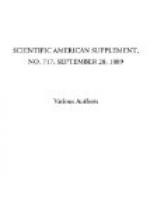1. With care it is always ready for use, and as no battery is required nor anything more than the turning of a handle, any person can work it.
2. It can be readily moved about from one part of a room or ward to another part.
3. If required for the sick it can be wheeled near the bedside and, by a tube, the ozone it emits can be brought into action in any way desired by the physician.
I refer in the above to the minor uses of ozone by this method, but I should add that it admits of application on a much grander scale. It would now be quite easy in any public institution to have a room in which a large compound Wimshurst could be worked with a gas engine, and from which, with the additional apparatus named, ozone could be distributed at pleasure into any part of the building. On a still larger scale ozone could be supplied to towns by this method, as suggested in Hygeiopolis, the model city.
It will occur, I doubt not, to the learned president of this section, and to others of our common profession, that care will have to be taken in the application of ozone that it be used with discretion. This is true. It has been observed in regard to diseases, that in the presence of some diseases ozone is absent in the atmosphere, but that with other diseases ozone is present in abundance. During epidemics of cholera, ozone is at a minimum. During other epidemics, like influenza, it has been at a maximum. In our paper Dr. Moffatt and I classified diseases under both conditions, and the difference must never be forgotten, since in some diseases we might by the use of ozone do mischief instead of good. Moreover, as my published experiments have shown, prolonged inhalation of ozone produces headache, coryza, soreness of the eyes, soreness of the throat, general malaise, and all the symptoms of severe influenza cold. Warm-blooded animals, also, exposed to it in full charge, suffer from congestion of the lungs, which may prove rapidly fatal. With care, however, these dangers are easily avoided, the point of practice being never to charge the air with ozone too abundantly or too long.
A simple test affords good evidence as to presence of ozone. If into twenty ounces of water there be put one ounce of starch and forty grains of potassium iodide, and the whole be boiled together, a starch will be made which can be used as a test for ozone. If ozone be passed through this starch the potassium is oxidized, and the iodine, set free, strikes a blue color with the starch. Or bibulous paper can be dipped in the starch, dried and cut into slips, and these slips being placed in the air will indicate when ozone is present. In disinfecting or purifying the air of a room with ozone, there is no occasion to stop until the test paper, by change of color, shows that the ozone has done its work of destroying the organic matter which is the cause of impurity or danger. For my own part, I have never seen the slightest risk from the use of ozone in an impure air. The difficulty has always been to obtain sufficient ozone to remove the impurity, and it is this difficulty which I hope now to have conquered.—The Asclepiad.




